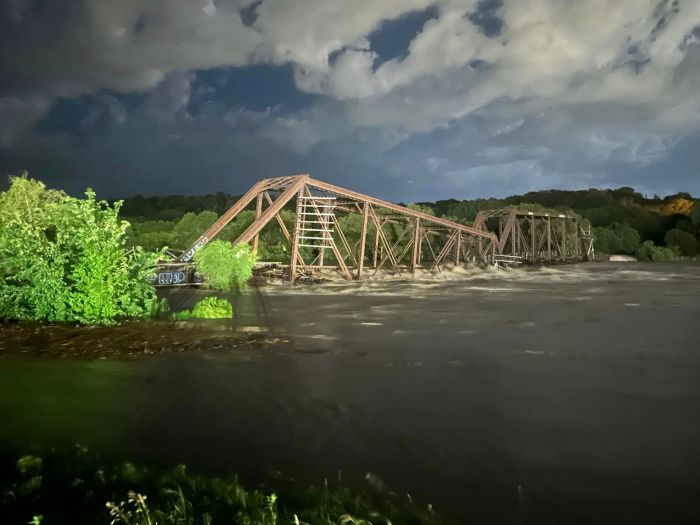

This bridge has been the centerpiece of the Great Flood of 2024 to date and is one that serves as a bitter sample taste for what is yet to come as floodwaters make its way south and potentially cut the States in half, like it happened in 1993. In fact the city where this bridge is located, together with Spencer, is an example of what will happen in the coming weeks and months as this will be the summer to forget, but will be considered unforgettable in the history books.
The North Sioux City Railroad Bridge is a two-span Pratt through truss bridge with steel girder approaches. Spanning the Big Sioux River at the Iowa-South Dakota border, this bridge was one of the last structures built by the Lassig Bridge and Iron Works Company of Detroit, Michigan in 1900 but at its original location in Cedar Rapids. In 1901, it became one of 28 bridge companies that merged to become the American Bridge Company as part of the deal by JP Morgan to purchase the assets from Andrew Carnegie, who later used his fortune to construct numerous libraries and places of fine arts, including Carnegie Hall. American Bridge Company still operates from its headquarters in Chicago to this day.
In 1905, the truss spans were relocated to its present-day site. As part of the plan to widen the river, American Bridge added girder spans on each end of the bridge in 1930. The bridge had a total length of 450 feet, of which each truss span had a length of 150 feet. The structure is currently owned by Burlington Northern Santa fe Railways (BNSF) and it serves a line connecting Sioux City with Aberdeen, via Hawarden and Sioux Falls.
In the wee morning hours of June 24th, floodwaters undermined the center pier holding the two trusses intact, causing one of them to collapse into the river. A facebook video reveals how the event happened ina matter of seconds:
At the present time, the collapsed span is still hanging on, yet the pressure from the floodwaters has caused that span to drift outwards, raising fears that it could break off and sink into the river. At the same time, the instability of the center pier is causing the standing span to sink. Already reports of the screeching and popping sounds of metal were made by local residents nearby and it’s a matter of time before the entire structure goes down into the river, especially as the Big Sioux River starts to recede after setting a record at 44.98 feet on the day of the bridge’s demise, smashing the record set in 1965 at 37 feet.
Regardless of what happens, the bridge will most likely be removed by BNSF as the railroad agency has been all out in replacing historic structures on its tracks because of its age and the increase in rail traffic. Whether or not it will be replaced remains open, as John Marvig mentioned in 2017, the route had been seeing three trains crossing the bridge per day on average. As the route has been detoured, it may be possible that BNSF will simply abandon the route and focus on more profitable routes. But because of damages to the tracks and other crossings, it may have to dig deeper into its financial treasure box to finance the rebuilding. If that happens, there may be a shining light on the future of the Bismarck-Mandan Railroad Bridge, the three-span through truss bridge that is being replaced. That project is expected to be delayed, buying time for a preservation group wanting to save the bridge to regroup and possibly take the railroad giant to the US Supreme Court in an attempt to halt the project or allow for two bridges to cross. But that will be a story for another time.
*********
If you have some photos and/or information of the bridges affected by the Great Flood of 2024, feel free to contact Jason Smith at the Chronicles, using the contact form here. They will then be showcased with some information that will follow on that.
For those who are traveling in the States this summer and happen to be in the central part of the country, please take extra precautionary steps to ensure you are out of harms way. Avoid areas that are underwater or affected by flooding. Obey traffic signs and do not go around barricades blocking roads. Laws save lives.
As far as swimming is concerned, consider indoor pools and waterparks as alternatives for many lakes affected by the Great Flood have been contaminated with bacteria and other chemicals from the runoffs that are considered harmful to humans as well as pets. Much of it can be found on the beaches. It normally takes 6 to 9 months for it to break down and for the water to be safe again for swimming. Please pay attention to the local department of natural resources and their advisories on swimming and boating before embarking.
Check your lodging possibilities and replan if necessary. If you are in the area affected by the floods, it had better be for helping residents (including sandbagging and clean-up) and not for disaster tourism. Put the people first before the phone and no fear mongering in social media. Take extra care of yourself and your loved ones.
************
Not just the bridges matter, but your community matters the most. ❤


